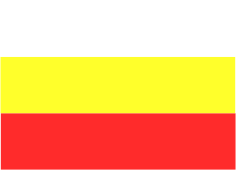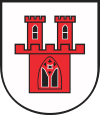Grodków
- For the village in Silesian Voivodeship, see Gródków. For the German-American socialist, see Paul Grottkau.
| Grodków | |||
|---|---|---|---|
|
Town hall and town square | |||
| |||
 Grodków | |||
| Coordinates: 50°41′N 17°22′E / 50.683°N 17.367°E | |||
| Country |
| ||
| Voivodeship | Opole | ||
| County | Brzeg | ||
| Gmina | Grodków | ||
| Government | |||
| • Mayor | Marek Andrzej Antoniewicz | ||
| Area | |||
| • Total | 9.88 km2 (3.81 sq mi) | ||
| Population (2007) | |||
| • Total | 8,709 | ||
| • Density | 880/km2 (2,300/sq mi) | ||
| Time zone | CET (UTC+1) | ||
| • Summer (DST) | CEST (UTC+2) | ||
| Postal code | 49-200 | ||
| Car plates | OB | ||
| Website | http://www.grodkow.pl | ||
Grodków [ˈɡrɔtkuf] (German: ![]() Grottkau ) is a town in Brzeg County, Opole Voivodeship in Poland, the administrative seat of Gmina Grodków. It is located in the Silesian Lowlands of the Oder basin, in the historic Upper Silesia region, about 20 km (12 mi) south of Brzeg. In the north it has access to the A4 autostrada. The town has 8,709 inhabitants (2007).
Grottkau ) is a town in Brzeg County, Opole Voivodeship in Poland, the administrative seat of Gmina Grodków. It is located in the Silesian Lowlands of the Oder basin, in the historic Upper Silesia region, about 20 km (12 mi) south of Brzeg. In the north it has access to the A4 autostrada. The town has 8,709 inhabitants (2007).
Before 1945 the town was part of Germany (see Territorial changes of Poland after World War II).
History
The settlement of villa Grodcobichi in the Duchy of Silesia was first mentioned in a 1210 deed. The neighbouring town of Neu Grottkau was laid out by German settlers in the course of the Ostsiedlung, it was granted city rights in 1268 by the Silesian duke Henryk IV Probus. The medieval city plan was characterized by a rectangular marketplace and four streets leading to the towers of the city gates and the nearby towns of Nysa, Ziębice, Wrocław and Lewin. Upon the 1311 partition of the Silesian duchy, Grodków fell to the Duchy of Brzeg ruled by Duke Bolesław III the Generous, who became a Bohemian vassal in 1327. In 1344 he sold the town to Bishop Przecław of Wrocław, who attached it to his Silesian Duchy of Nysa. Later their suzerain, the Bohemian king Wenceslaus, granted the Wrocław bishops the title of a "Duke of Grodków", which they retained until the secularisation of the bishopric in 1810.

Grottkau was devastated during the Hussite Wars and again in the Thirty Years' War, after which it was rebuilt under the rule of its native son Bishop Sebastian von Rostock. With the Bohemian kingdom, the town was incorporated into the Habsburg Monarchy in 1526. After the First Silesian War of 1740-42, it was annexed by King Frederick the Great of Prussia, the Prussian garrison established after the Seven Years' War in 1763 was not disbanded until 1920. From 1815 onwards, Grottkau was part of the Silesia Province.
The town had 4,867 inhabitants in 1939 and was the seat of Landkreis Grottkau until 1945. The town was heavily damaged during the Vistula–Oder Offensive of the Red Army. After World War II, the German population was expelled according to the resolutions of the Potsdam Agreement.
Notable people
- Melchior Adam (1575–1622), literature historian
- Sebastian von Rostock (1607–1671), Bishop of Wrocław
- Józef Elsner (1769–1854), composer
- Sylvius Leopold Weiss (1687–1750), composer
- Hermann von Roeder (1797–1857), Prussian General
- Julius von Roeder (1806–1889), Prussian General
- Johannes Ronge (1813–1887), founder of the German Catholics, worked as a chaplain at the Grottkau parish church from 1840 to 1843.
- Bruno von Kern (1860–1932), Prussian General
- Hans-Georg Herzog (1912–1959), Wehrmacht officer
- Helmut Scholz (1920-1997); German officer
International relations
Twin towns - Sister Cities
Grodków is twinned with:
-
 Beckum, Germany
Beckum, Germany -
 Bohumín, Czech Republic
Bohumín, Czech Republic -
 Heringsdorf, Germany
Heringsdorf, Germany -
 La Celle-Saint-Cloud, France
La Celle-Saint-Cloud, France -
 Borschiv, Ukraine
Borschiv, Ukraine
Sources and references
![]() This article incorporates text from a publication now in the public domain: Herbermann, Charles, ed. (1913). "article name needed". Catholic Encyclopedia. New York: Robert Appleton.
This article incorporates text from a publication now in the public domain: Herbermann, Charles, ed. (1913). "article name needed". Catholic Encyclopedia. New York: Robert Appleton.
External links
- (Polish) biggest website
- (Polish) Municipal website
- (German) Heimatstube der Grottkauer
- Jewish Community in Grodków on Virtual Shtetl
| Wikimedia Commons has media related to Grodków. |
Coordinates: 50°42′N 17°23′E / 50.700°N 17.383°E

